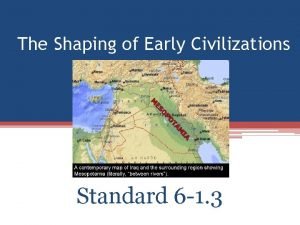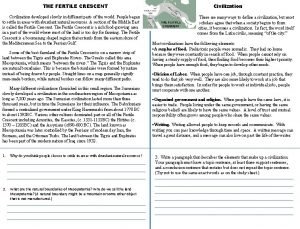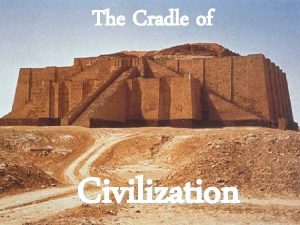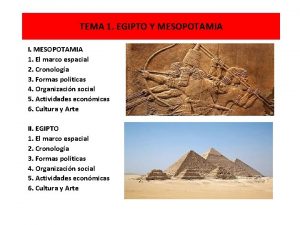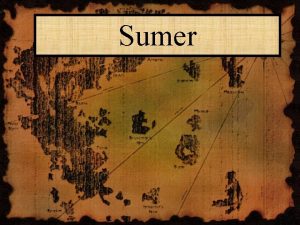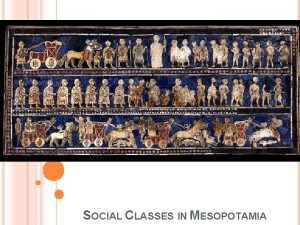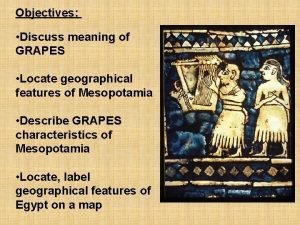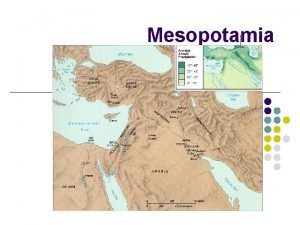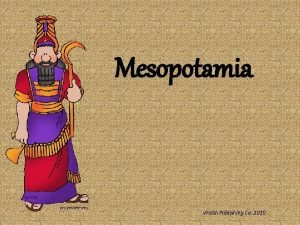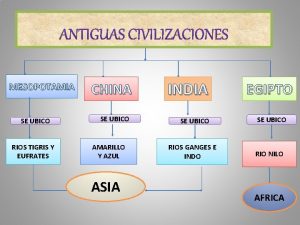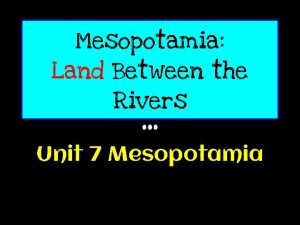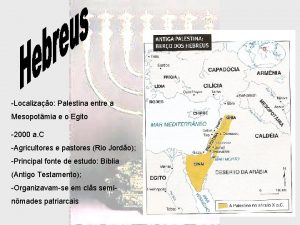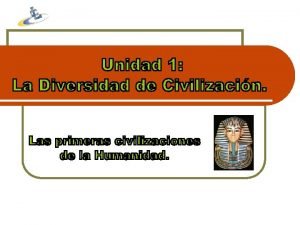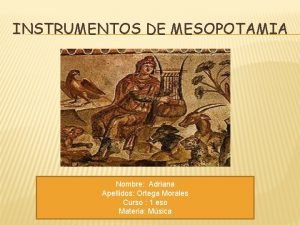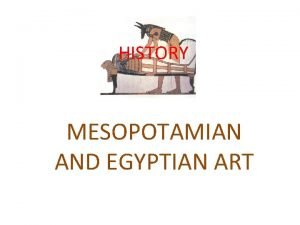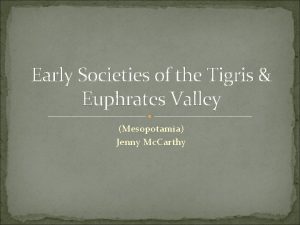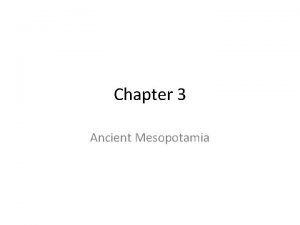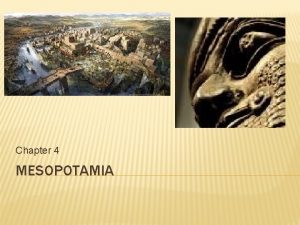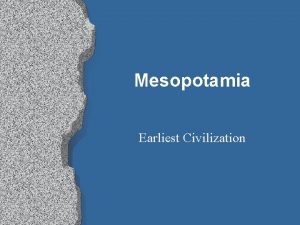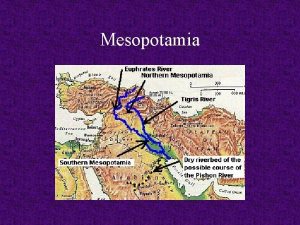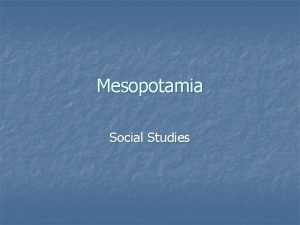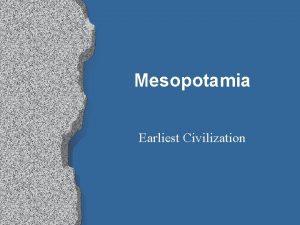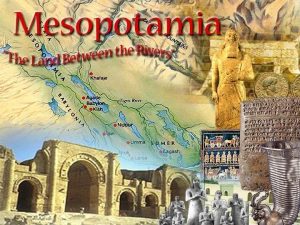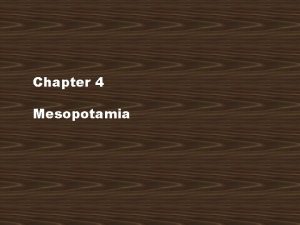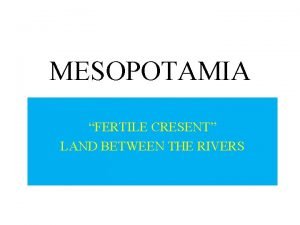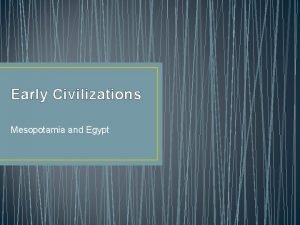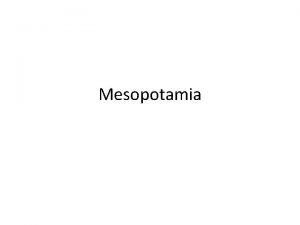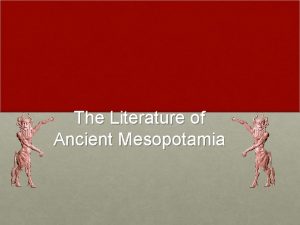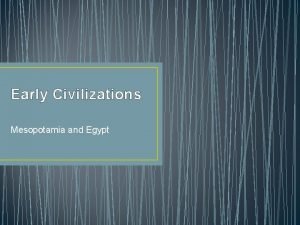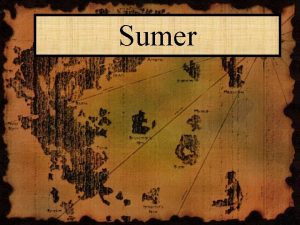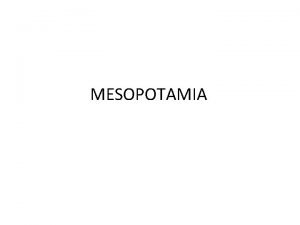Chapter 4 MESOPOTAMIA QUICK WRITE Write one to







































- Slides: 39

Chapter 4 MESOPOTAMIA

QUICK WRITE… � Write one to two paragraphs about how humans switched from nomadic life to living in cities. Also explain what characteristics qualifies a place to be considered a civilization. � Now think about what we learned from the video yesterday about Mesopotamia. How has things from Mesopotamia affected how we continue to live today?

WHAT IS A CIVILIZATION? � There are many ways to define a civilization, but most scholars agree that when a society begins to form cities, it becomes a civilization. In fact, the word civilization comes from the Latin civilis, meaning "of the city. " Most civilizations have the following elements: • cities �A surplus of food • complex institutions � A division of labor • record keeping � Organized government and religion • specialized workers � Writing • advanced technology

GUIDING QUESTIONS � Why did people settle in Mesopotamia? � What was life like in Sumer? � How did Mesopotamia’s first empire develop? � Why was Babylon an important city in the ancient world?

LESSON 1: THE SUMERIANS Vocabulary � Civilization � Silt � Irrigation � Surplus � City-state � Polytheism � Ziggurat � Cuneiform � Scribe � Epic


THE FIRST CIVILIZATIONS IN MESOPOTAMIA � � � Began in a plain located between the Tigris and Euphrates River Located in present-day Iraq. Lasted from 3000 B. C. to 500 B. C. Flooded rivers were filled with silt (fine particles of fertile soil) that made farming easy. Built dams to control seasonal floods and dug canals to let water flow to their fields. This is called irrigation (a system that supplies dry land with water through ditches, pipes, or streams. ) This let farmers grow surpluses (more than

LESSON 1: THE TWO RIVERS � Mesopotamia means “the land between the rivers” in Greek � The land where Mesopotamia sat is called the Fertile Crescent.

EARLY VALLEY DWELLERS � In the 1800 s archaeologists found many buildings and artifacts that revealed a lot about early Mesopotamia. � It is believed that the first settlers came to the area around 7000 B. C. E. as hunters and herders � Around 4000 B. C. E. people began to build farming villages near the two rivers (Tigris & Euphrates).

TAMING THE RIVERS � Flooded rivers were filled with silt, or small particles of soil, which it made it easier to farm � People learned to build dams and dug canals that let water flow to their fields. This method is called irrigation. � Irrigation is a system that supplies dry land with water through ditches, pipes or streams. � Irrigation allowed farmers to grow a surplus, or extra

TAMING RIVERS (CONT. ) � Everyone wasn’t needed for farming, so they became artisans, which are skilled workers � The more goods the artisans made, the more people began to trade. � Small farming villages became big trading cities

SUMER’S CIVILIZATION � Sumer was a region in Mesopotamia � Sumer’s people are known as Sumerians � Sumerians built the first cities called Ur, Uruk and Eridu.


CITY-STATES ARISE � Cities were surrounded by mudflats and patches of scorching desert. � Harsh landscape made it hard to travel from city to city. � As cities grew they gained more economic and political power � Cities became city-states, which means each city had its own government � Historians believe city-states were protected by a large city wall. � City-states went to war with each other over resources and

GODS, PRIESTS AND KINGS � � � Sumerians worshipped many gods, which is known as polytheism. Gods control different parts of nature and guided the daily tasks people did. Each city-state claimed one god as its own god. Each city-state built large temples called ziggurats. Only special priests were allowed to go into the temple at the top of the ziggurat

LIST OF SUMERIAN CITY-STATES � � � Kish (modern-day city of Tell al-Uhaimer) Uruk Ur (modern-day city of al. Mukayyar) Sippar Akshak Larak Nippur Adab Umma Lagash (modern-day city of Tello) Bad-Tabira Larsa

Rise of the City-States Project • Your group will be creating a museum exhibit for a Sumerian city-state! • The city-state’s presentation must include the following: a. Geography (physical map) b. Religion c. Social Groups/Hierarchies d. Work/Trade e. Government • Blue: Eridu Green: Uruk Yellow: Kish Orange: Ur Pink: Nippur Purple: Akkad

Rise of the City-States Project • You must include only images in your presentation. • When you present, you will speak to the class about your section. You may use notes, but you are not to read. • Sources are limited to museum sites, encyclopedias, or university (. edu) sites. • A citation page person must be included. • You should include citations for pictures and information. • Each group member is responsible for one section. • Each member should have at least 5 slides/images of actual artifacts (not drawings). • Each member should also include a title slide. • Group members will combine their slides to create one group presentation.

SUMER

SOCIAL GROUPS � People in Sumer were divided into social groups � Upper class: kings, priests, warriors, government officials and royal families � Middle Class (largest group): merchants, farmers, fishers, and artisans � Lower class: Enslaved people, which included people captured during war, criminals and people who couldn’t pay their debts. They worked for the upper class

SUMERIAN CONTRIBUTIONS � � � Sumerians created the first system of writing called cuneiform. Cuneiform was written by cutting wedge-shaped marks into damp clay w/ a sharp reed Scribes were people trained to read and write. They kept records for everything in the society. People had to go to school to learn to be scribes. Wrote the first story called Epic of Gilgamesh Epic is a long poem that

TECHNOLOGY AND MATHEMATICS Sumerians invented many things: � The wheel � The cart pulled by donkeys � The chariot � Sailboat � Wooden Plow � Potter’s wheel � Bronze for tools and jewelry � 12 -month calendar

TECHNOLOGY AND MATHEMATICS (CONT. ) � Sumerians studied math and astronomy � Used geometry to measure the size of fields and building plans � Created place-value system of numbers based on 60 � Watched position of stars to show them when it was the best time to grow crops and to hold religious ceremonies.

THE FIRST EMPIRES Guiding Question: How did Mesopotamia’s first empires develop � By 2400 BC, Sumer’s city-states were weakened by conflict. � Powerful kingdoms arose in Mesopotamia and Syria � Empires grew and cultures spread through conquest and trade

WHO WAS SARGON? � Ambitious leader who ruled the Akkadians in Akkad. � 2340 B. C. , Sargon conquered the remaining Sumerian city-states one by one. � United Sumer and Akkad and made the first empire � Cultures mixed: People spoke the Akkadian language but wrote in Sumerian cuneiform. � Empire lasted for more than 200 years

WHO IS HAMMURABI? Babylonian king who conquered cities controlled by Amorites in 1792 B. C. � Created the Babylonian empire. � Babylon located on the east bank of what is now Iraq �

HAMMURABI’S CODE � � Hammurabi created a set of laws called Hammurabi’s Code Posted the laws for everyone to read on a pillar-like stone known as a stele. Dealt with crimes, farming, business, marriage and the family and protected the less powerful Stricter than old Sumerian laws Law became known as “eye for an eye, tooth for a tooth” law

THE ASSYRIAN EMPIRE � � Empire arose about 1, 000 years after Hammurabi’s empire Extended into presentday Syria, Turkey, Iran and Iraq. Assyrians had a powerful military In 900 B. C. the army began taking over the rest of Mesopotamian land

THE ASSYRIAN ARMY Assyrian army was well trained and disciplined � Army made up of: � Infantry – foot soldiers � Calvary –horse soldiers � Charioteers � � Fought with: Slingshots � Bows and arrows � Swords and spears �

THE ASSYRIAN ARMY � Ruthless in Battle: � Robbed people � Set crops on fire � Destroyed towns and dams � Took tribute – forced payments � Drove people out of their homes � Stories spread and people feared them, some gave up without a fight

KINGS AND GOVERNMENT � Assyrian empire extended from the Persian Gulf in the east and to the Nile River west � Assyrian capital was Nineveh � Divided empire into provinces, or political districts � Government built roads to connect the provinces � Kings chose officials to govern, collect taxes and carry out the laws in each province � Soldiers stood guard at stations along the roads

LIFE IN ASSYRIA � � � � � Lives were built on what they learned from Mesopotamians Had laws codes but punishments were harsher Writing based on Babylonian writing Worshipped many of the same gods Built large temples and palaces filled with wall carvings and statues. Wrote and collected stories King Ashurbanipal built one of the world’s first libraries in Nineveh. Farming and trade were important Brought metal and wood from faraway to supply empire

THE CHALDEAN EMPIRE – THE NEW EMPIRE Chaldeans were the descendants of the Babylonians under the rule of King Hammurabi. � Assyrians fought over who would be the next ruler and the Chaldeans took over � Chaldeans were once ruled by the Assyrians and they hated them � In 627 B. C. King Nabopolassar reclaimed his throne and led a revolt against the Assyrians � The Medes people joined the Chaldeans and forced the Assyrians out of Uruk � Captured Assyrian capital of Nineveh. � Chaldean Empire sometimes referred to as the New Babylonian Empire. �

THE GREATNESS OF BABYLON King Nebuchadnezzar, the son of King Nabopolassar, created a new empire. � Made Babylon the largest and richest city in the world, which was surrounded by a huge wall. � Huge palaces and temples were in the middle of the city with a more than 300 ft tall �

WONDER OF THE WORLD King Nebuchadnezzar built the Hanging Gardens of Babylon for his wife. � Hanging Gardens became one of the Seven Wonders of the Ancient World. �

ANOTHER WONDER…. � The Ishtar Gate built in about 575 B. C. E. by order of King Nebuchadnezzar II

THE GREATNESS OF BABYLON � Babylonians built many canals making the land more fertile � Nebuchadnezzar collected high taxes to pay for his building projects and maintain his army. � The major trade route between the Persian Gulf and Mediterranean Sea passed through Babylon

THE GREATNESS OF BABYLON Merchants traveled in caravans, a group of merchants traveling together for safety w/ a lot of camels. � Chaldean astronomers mapped the stars, planets and phases of the moon as it changed. � Invented one of the first sundials � The first to to follow a seven-day week. �

FALL OF THE EMPIRE � After Nebuchadnezzar dies, a series of weak kings rules the empire. � Poor harvest and slow trade weakened the empire more � The Persians captured Babylon after they realized the Chaldeans lost their strength and leadership � Persians let the Chaldeans keep their distinct culture.
 Quick find algorithm
Quick find algorithm 1.7.6 - quick check: frost quick check
1.7.6 - quick check: frost quick check One god one empire one emperor
One god one empire one emperor One one one little puppy run
One one one little puppy run One king one law one faith
One king one law one faith One empire one god one emperor
One empire one god one emperor One team one plan one goal
One team one plan one goal See one do one teach one
See one do one teach one See one, do one, teach one
See one, do one, teach one Night structure
Night structure Studiendekanat uni bonn
Studiendekanat uni bonn One vision one identity one community
One vision one identity one community Asean one vision one identity one community
Asean one vision one identity one community Fcat writing prompts
Fcat writing prompts Avid quickwrites
Avid quickwrites Quick breads and batters chapter 41 answers
Quick breads and batters chapter 41 answers Study guide chapter 10 section 1 meiosis
Study guide chapter 10 section 1 meiosis Conclusion of mesopotamian civilization
Conclusion of mesopotamian civilization Mesopotamia social order
Mesopotamia social order Mesopotamia poem
Mesopotamia poem Ancient mesopotamia timeline
Ancient mesopotamia timeline Cuadro comparativo egipto antiguo y actual
Cuadro comparativo egipto antiguo y actual 2 rivers in mesopotamia
2 rivers in mesopotamia Mesopotamia social classes
Mesopotamia social classes Warisan mesopotamia
Warisan mesopotamia Organizacion politica de la mesopotamia
Organizacion politica de la mesopotamia Geographic features of mesopotamia
Geographic features of mesopotamia Two rivers in mesopotamia
Two rivers in mesopotamia Mesopotamia map activity
Mesopotamia map activity Mesopotamia contribution
Mesopotamia contribution Mesopotamia se ubicó entre los ríos
Mesopotamia se ubicó entre los ríos Perfect location
Perfect location Unang grupo ng mga tao na nakatuklas ng gulong.
Unang grupo ng mga tao na nakatuklas ng gulong. Inventos mesopotamia
Inventos mesopotamia Palestina hebreus
Palestina hebreus Media luna fértil civilizaciones
Media luna fértil civilizaciones Organización política y social de mesopotamia
Organización política y social de mesopotamia Instrumentos mesopotamicos
Instrumentos mesopotamicos Doryphoros
Doryphoros Mesopotamia weapons
Mesopotamia weapons


















